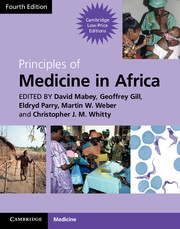Book contents
- Frontmatter
- Contents
- Contributors
- Foreword
- Section 1 Health and disease
- Section 2 Mother and child health
- Section 3 Infection: general principles
- Section 4 Major common infections
- 16 Malaria
- 17 HIV/AIDS
- 18 Tuberculosis
- 19 Pneumonia in adults
- 20 Meningitis
- 21 Sexually transmitted infections
- Section 5 Bacterial infections
- Section 6 Viral Infections
- Section 7 Protozoal infections
- Section 8 Helminth infections
- Section 9 Fungal infections
- Section 10 Non-communicable diseases
- Section 11 Diseases of body systems
- Section 12 Cancer and Palliative Care
- Section 13 Venoms and Poisons
- Index
- References
18 - Tuberculosis
from Section 4 - Major common infections
Published online by Cambridge University Press: 05 March 2013
- Frontmatter
- Contents
- Contributors
- Foreword
- Section 1 Health and disease
- Section 2 Mother and child health
- Section 3 Infection: general principles
- Section 4 Major common infections
- 16 Malaria
- 17 HIV/AIDS
- 18 Tuberculosis
- 19 Pneumonia in adults
- 20 Meningitis
- 21 Sexually transmitted infections
- Section 5 Bacterial infections
- Section 6 Viral Infections
- Section 7 Protozoal infections
- Section 8 Helminth infections
- Section 9 Fungal infections
- Section 10 Non-communicable diseases
- Section 11 Diseases of body systems
- Section 12 Cancer and Palliative Care
- Section 13 Venoms and Poisons
- Index
- References
Summary
The problem in Africa
Tuberculosis (TB) is one of the most serious threats to public and individual health in Africa. In 1993, the World Health Organization (WHO) took the unprecedented step of declaring TB to be a global emergency. Since then, despite the WHO's Stop TB Strategy and significant strides taken in scaling up TB diagnostic and treatment services, control of the global TB pandemic has remained elusive. In 2008, there were an estimated 9.4 million TB cases globally and close to 1.8 million TB deaths (WHO, 2009a). Africa has the highest burden of disease per head of population, with an estimated incidence rate of 363 TB cases per 100 000. The driving force behind the African TB epidemic is the other major epidemic of human immunodeficiency virus (HIV) infection. Not only has HIV been responsible for the tremendous increase in numbers of TB cases seen in the region in the last 15 years, but it threatens TB control efforts by further stigmatizing the disease, complicating the diagnosis, reducing the effectiveness of treatment, increasing TB recurrence rates and facilitating the spread of drug-resistant disease.
In this chapter we discuss the epidemiology, pathogenesis, clinical features, diagnosis, treatment and prevention of TB, and explain how this fits together within a framework for TB control. In all these areas, we emphasize the strong link with HIV. The best chance of detecting the disease, curing the patients and halting transmission lies in having a strong countrywide TB control programme and effective collaborative activities with prevention and treatment of HIV, and we highlight how these should work.
- Type
- Chapter
- Information
- Principles of Medicine in Africa , pp. 232 - 253Publisher: Cambridge University PressPrint publication year: 2013



